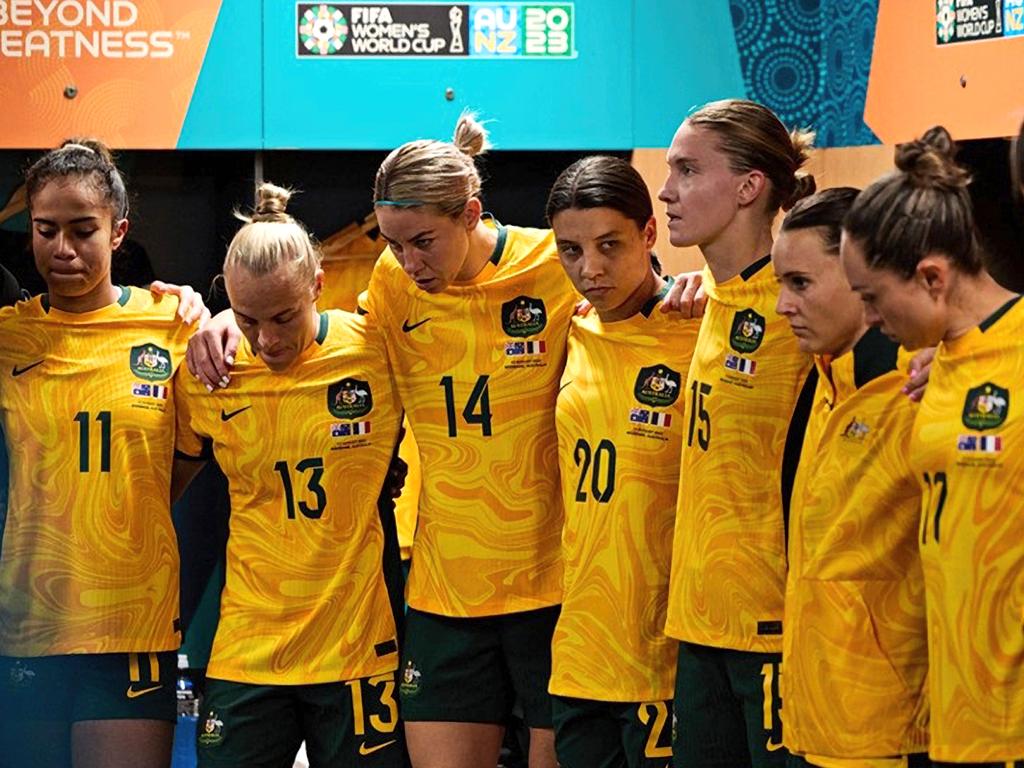Matildas a huge TV success, but will the World Cup translate into a big payday for Football Australia?
The country’s viewers fell in love with the Matildas. But the hard work starts now for soccer executives who need to convince TV networks their sport is worth paying big money for.

The Matildas have been a stunning television success, but now the hard work really begins for Football Australia.
Soccer’s governing body is about to go to market for its next broadcast rights deal for four years from 2025 onwards – a deal it would like to strike by the end of this year.
FA boss James Johnson is hoping to surf the Matildas and Women’s World Cup boom, declaring “we’re expecting a record-breaking broadcast deal” as a result of the massive interest in the sport over the past four weeks.
At first glance, Johnson’s confidence would appear to be well-placed. The Matildas smashed a series of broadcast records during their run to the semi-finals, capped with a huge audience last Wednesday night.
The interest is there. That semi-final against England drew a staggering 7.132m views on free-to-air broadcaster Seven West Media – the biggest TV audience in 20 years.
The World Cup has proven a bargain for Seven, which paid only about $5m to main rights holder Optus in a sub-licence deal for only a portion of World Cup matches. To be fair to Optus, it too has had a great time of it. While metrics for phone companies showing sport are always harder to measure, it apparently had more than 300,000 people streaming that Matildas game against England.
So in the wake of the huge TV audiences, Johnson and the FA will try to convince the TV networks to pay up big for soccer rights – and at least get more than the $100m Network 10 and its streaming service Paramount are paying for about 3½ years worth of rights to the Matildas and Socceroos games.
It may not be as easy as it seems, and the current deal with Ten shows why. On the eve of the World Cup, the Matildas played a warm-up match against France in Melbourne. The match was sold out, with about 50,000 spectators cramming into Marvel Stadium on a Friday night to catch a glimpse of Matildas heroes like Sam Kerr and Mary Fowler. Meanwhile, only about 299,000 viewers tuned into the telecast on Ten.
Fast forward a few weeks and the same matchup, Australia versus France in the World Cup quarterfinals, was watched by an average audience of 4.17m on Seven. Now, that is not exactly a like-for-like comparison. One game was pre tournament on Ten and one was a thrilling knockout match for Seven.
But the two matches also prove what a challenge it is to go market for FA, and also why just about all sports want to be on Seven or Nine Entertainment Co rather than the distant third-ranking free-to-air network in Ten.
That will upset Ten but the AFL, Cricket Australia, Rugby Australia and even, currently, the Victoria Racing Club with its Melbourne Cup rights, are among the sports to have moved away from Ten in recent years.
Sports simply seem to rate far higher on Seven and Nine.
So the challenge for Johnson and the FA is to try to convince Seven or Nine that Matildas and Socceroos games – outside of World Cups – are worth bidding more that $100m for four years. Or it stays with Ten, and its Paramount streaming service (which has a separate A-League rights deal), or a hybrid deal with Optus and a TV company.
A couple of things may play into soccer’s favour.
Johnson will try again to package Asian Football Confederation rights into the deal (which means the FA buys the rights first from AFC), and FA wants to host the Women’s Asian Cup in 2026.
After the huge success of the Women’s World Cup, another home tournament starring the Matildas would guarantee big ratings.
FA could also speculate to accumulate by launching an audacious pitch for World Cup rights itself – world governing body FIFA has launched the bidding process for Australian rights to the 2026 and 2027 Men’s and Women’s World Cups – and then onsell it to the networks as part of its package.
They would be costly, but in the end lucrative, moves.
There are some negatives, which Seven boss James Warburton alluded to last week when saying it was harder to monetise soccer on its broadcasts given the lack of natural breaks in play in which to insert advertisements. That is not an insurmountable issue – soccer rights are huge around the world – but there is still an education process for the big local networks to get them to love the sport more than just for big events. Then there is the fact that Seven and Nine have splashed out big money for AFL, NRL, the Olympics, cricket and rugby union. Is there enough money left for soccer?
The World Cup is over but the big media game for Football Australia is only just starting.








To join the conversation, please log in. Don't have an account? Register
Join the conversation, you are commenting as Logout